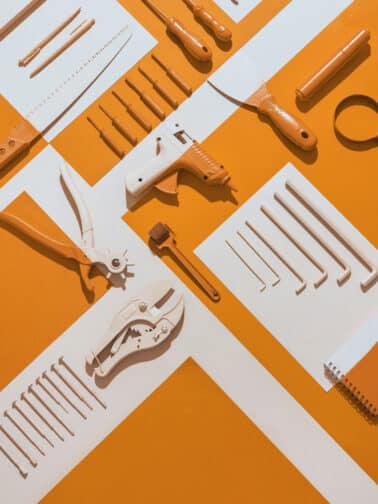But/and, I also and specifically want to talk about how hard it can feel for those who come from relational trauma backgrounds to even remotely know what brings them joy if they didn’t experience joy in their childhood and/or if they have a hard time connecting to their bodies.
If this is you – if the idea of what brings you joy mystifies you and you have no clue what this might mean or how to bring more of it into your life but you’re curious and eager to do so – please keep reading.
What is joy?
Joy. Sounds so simple, doesn’t it? But what actually is joy?
Merriam-Webster defines joy as a noun as:
- A : the emotion evoked by well-being, success, or good fortune or by the prospect of possessing what one desires : DELIGHT
B : the expression or exhibition of such emotion : GAIETY
- a state of happiness or felicity: BLISS
- a source or cause of delight
And the definition of joy as a verb is:
- : to experience great pleasure or delight: REJOICE
From any angle, from whatever definition you choose, joy, quite frankly, feels GOOD.
Why is joy important?
Why is joy so important?
Aside from the fact that it feels good (see the above definitions), joy is one of the keys on the emotional keyboard of life we can and should be able to access in order to proverbially play the richest and most enlivened emotional music possible.
What do I mean by this?
If you imagine a piano keyboard and all its attendant, beautiful black and ivory keys, you can imagine that each key represents an emotion that we experience in our human lives: sadness, lust, grief, horror, anger, peace, contentment, pride, impatience, love, devotion, and so forth.
With the emotional keyboard of life, the goal is not to learn and be able to play only a few keys.
The goal is, instead, to learn how to play the richest piece of music possible by developing your capacity to feel and appropriately express each of the proverbial keys on this keyboard.
And joy is one of these keys.
And it is, quite frankly, a really delightful and delicious one to feel!
I would also argue that, for those who come from relational trauma backgrounds, it becomes even more important for you to learn how to “play this key” so to speak.
Why?
Because so often when we come from relational trauma backgrounds the general overtone of our lives can be dominated by notes and themes of hardness, heaviness, suffering, fear, lack, challenge, and survival.
After so much time playing these particular keys on the keyboard and having missed out on the joy all children are entitled to early in life, we then owe it to ourselves as adults to learn how to play this proverbial key and to intentionally play it more often in the music of our days.
How do I know what brings me joy?
But how do you know what brings you joy if you had a childhood deprived of joy?
And even if you don’t come from a relational trauma background, how do you begin to feel joy when you are, quite frankly, utterly exhausted, burned out, and totally depleted given the stress, overwhelm, and responsibilities of your days?
To the latter, I would say this: it is very, very hard to feel what brings you joy when you are burned out.
So your first order of business is to rest deeply and recover from burnout and come back to a psychological and physiological baseline.
Only then will you be able to better feel what brings you joy.
And to those who identify with coming from a relational trauma background, our work to discover what brings us joy is two-fold:
- We must become more embodied; and…
- We must expose ourselves to more activities, experiences, and situations to see what signals joy in our bodies.
Using your body to discover what brings you joy.
I want to honor and acknowledge that, for those of us who come from relational trauma backgrounds, in order to survive our early childhoods, many of us may have learned to disconnect from our bodies — the place where we felt so many overwhelming and sometimes devastating feelings.
And so, as we ask the question – What brings me joy? – we also need to learn how to gently, slowly, attentively begin to befriend our bodies again, tracking them for the sensations that indicate we are responding to something that it is bringing us joy.
We may need to learn to become embodied again in order to figure out what brings us joy.
This may sound like a tall and overwhelming task, but it doesn’t have to be.
We can take teeny tiny baby steps to help you befriend your body again and track down the somatic sensations of what brings you joy.
You can start to pay attention to your breath (In and out, In and out…), to the sensations of warmth and coolness in your body (Am I cold right now? Do I need socks? Am I too warm? Do I need to turn the AC on?), to the sensations of your bowels and digestive tract (Do I need to pee or poop? Am I hungry? Am I thirsty?).
These questions and invitations may seem small and obvious but if you’ve spent your life divorced from your body, beginning with basic biological questions and tracking like this can help you begin to be more embodied and increase your awareness about how certain situations and experiences evoke different sensations inside of your body.
And please know: this can take time and there is not one single way that joy looks and feels for us all.
It’s subjective and unique so you will need to be your own detective to determine how and what joy feels like for you.
Joy can be big and obvious and grand, but it can also feel the teeniest, tiniest whisper, a faint trace of something that feels like a pulling-towards.
I think about that bathtub scene from Eat, Pray, Love when Julia Roberts (playing the extraordinary Elizabeth Gilbert) is sitting with her Italian dictionary, letting the words roll around in her mouth, acknowledging that the only thing she could feel anything for (in the wake of her terrible divorce) was for the Italian language and how it felt in her mouth.
And so she moved toward this thing, this felt sense of something good, no matter how slight it was. And her journey thus unfolded…
For me, I’ve learned through tracking my somatic sensations over time that joy feels like a sense of buoyancy inside of me – like a wide, soft balloon inflating inside my chest and core that makes me feel lighter that also evokes some ephemeral sense of nostalgia in me, recalling a felt sense of a time in my life where possibilities and paths felt more expansive, freer, more limitless. And so now I move towards that feeling.
But again, before I could even understand what evokes joy for me, I had to become embodied again.
Only then could I register when something brought me joy.
So after becoming more embodied and more familiar with the subtle sensations in your own body, you can then discover what brings you more joy by exposing yourself to more situations, activities, circumstances, and places that will allow you to track how they make you feel.
But how do we do this?
How do we expose ourselves to potential joy-inducing activities?
For many of my readers and clients who come from relational trauma backgrounds, as children, they may not have been exposed to a wide range of activities, hobbies, and circumstances that would have helped them identify what brings them joy.
So one of my favorite homework assignments for clients and online course students is this:
Start exposing yourself to a wide variety of activities and interests like you might with a small child to help them discover the world and their interests.
What do I mean by this?
I’ll share a story: Before having my daughter, my life was really quite dominated by work – grad school, accumulating my hours for my license, blogging, laying the groundwork to open up a trauma-informed therapy center, steeping myself in post-graduate trauma training, etc.
I’m embarrassed to admit my days and weeks were pretty single note: work, work, work.
Now, please understand, I adore my work and feel like it’s a calling and not just a job.
So on the one hand, I loved what I was doing but I can also see now that I was doing a pretty poor job of giving myself adventures, variety, and stimulation in the form of new experiences, something which my inner child really craved.
But then, in 2018, along came my daughter, and my world fundamentally changed.
Life centers around her now, not my work.
And as she grew from an infant to a baby to a toddler, my desire to give her a rich, interesting, and magical childhood grew and grew and so did my desire to proactively seek out activities, experiences, and circumstances that could expose her to this wide, great world.
I proactively spend time crowdsourcing recommendations from fellow Bay Area toddler parents of places to go and things to do.
I book tickets to special events, outdoor museums, one-off shows, and we tour playgrounds all over the Bay.
I make sure to introduce her to different cuisines, different vistas, different types of music and books, and art supplies.
I intentionally cultivate and create opportunities for her to experience newness and potentially discover her new favorite things.
Parenting my daughter so intentionally has helped me experience more adventures in my own weeks, but has also catalyzed me to think more deliberately about how to give myself the adult equivalent of what I give her: new experiences, diverse activities, little adventures so that I can have the chance to register joy in my body more.
So if you, like so many of us who come from relational trauma backgrounds, have a hard time discovering what brings you joy, focus on becoming more embodied as a first step, but then try giving yourself what a good-enough parent would give to their growing child: a diverse array of activities, experiences, and adventures to see what in this big, beautiful world can evoke joy in your body.
And then double down on what you notice does bring you joy.
Do this again and again so you can play that keyboard key as often as possible to make your days and weeks feel better.
What’s bringing me joy these days…
And now, to wrap up this essay, I want to share what’s personally bringing me joy these days – allowing me to register that delicious somatic sensation in my body:
- Watching (and re-watching) the incredible TV show Ted Lasso and then talking about it with my husband and best girlfriends after new shows come out on Fridays (digesting it with my loved ones is more fun than the show for me!).
- Listening to Glennon Doyle’s terrific podcast We Can Do Hard Things twice a week when it comes out.
- 90’s music bike rides and runs on Peloton – 90’s were the time I came of age and every song from that era is super nostalgic for me (ditto the Disney-themed rides and runs on Peloton!).
- The Christmas tree whose every square inch is covered by ornaments and whose size is taking up a good third of our teeny tiny living room; also the nutcrackers on our mantel, the red and white striped stockings hung, and Christmas music playlists on Spotify.
- Balsam fir scented candles burned for no special reason, just because.
- Wearing blouses with pretty little colorful prints.
- Making my daughter’s daily preschool lunches in her Planet Rover bento lunch box – it is so little and cute and feels both like I’m making miniature meals for a doll and it reminds me of the time my husband and I visited Japan and I became obsessed with the ekiben on the bullet trains…
- Listening to cello music while sitting in my hot tub in the afternoon sun…
- And finally, this past Spring in Yosemite, feeling profoundly joyful riding a rented bike with an attached trailer with my daughter sitting in it, feeling the strength of my Peloton-trained muscles as I drove us both all over the valley…
And now I’d love to hear from you in the comments below:
What is bringing YOU joy these days? What experiences, circumstances, places, and things make you feel joyful?
And another question: How – as an adult – did you begin to notice and re-discover what brings you joy?
If you feel so inclined, please leave a comment below so our monthly blog readership of 20,000+ souls can benefit from your wisdom and experience.
If you would personally like support around this and you live in California or Florida, please feel free to reach out to me directly to explore therapy together.
If you live outside of these states, please consider enrolling in the waitlist for the Relational Trauma Recovery School – or my signature online course, Hard Families, Good Boundaries, designed to support you in healing your adverse early beginnings and create a beautiful adulthood for yourself, no matter where you started out in life.
And until next time, please take such good care of yourself. You’re so worth it.
Warmly, Annie






Being “embodied” is truly a new thing for me… and a blessing. My past self soothed with lengthy introspective periods which would sometimes lead me down torment lane. Sometimes depression would lead to nap a lot. As a single mom of 3, I am incredibly busy and thus have to fight to get time away to see what brings me joy. What I find frustrating is that because of my childhood, I doubt myself and what I think brings me joy so it is hard to settle on many things. If I am confident, I can arrive at a few things. If I am lacking confidence, I can only think of a couple things (coffee and being in the Lord’s presence).
Hi MS,
Thank you for your comment and for your insight. It’s true, finding our joy can take a little time and in our busy lives it can sometimes feel like a luxury to slow down and explore what truly brings us joy. I commend you for already having 2 things on your list and urge you to trust yourself to add to that list!
If either of my courses – Hard Families, Good Boundaries, or the forthcoming Relational Trauma Recovery School – could be of support to you, I would love to support you there. In the meantime, please take such good care of yourself. You’re so worth it.
Warmly, Annie
Your blog posts have helped me navigate the past two years, Annie. Thanks for sharing your wisdom here. I find joy in listening to the Spilled Milk (food comedy) podcast, taking walks by any body of water, grocery shopping, cuddling with my stuffed animal. It’s taken a long time to admit what brings me joy – I’ve feared that what brings me joy wouldn’t be accepted by my peers, especially the stuffed animal part. With the support of a kind spouse, I’ve leaned into it a lot more and am that much happier for it. Cheers to you and your team this holiday season!
Hi Joann,
Thank you for taking the time to leave this lovely comment! I am thrilled to hear that my words have helped you as being a source of support is really my goal in all of my work. Joy is very personal and I am proud of you for leaning into exactly what makes you happy. I’m glad you have the support of a kind spouse, that is wonderful to hear.
If you feel that either of my online courses – Hard Families, Good Boundaries, or the forthcoming Relational Trauma Recovery School – could be of support to you, I’d love to work with you there and help you find even more joy.
Sending my best to you.
Warmly, Annie
I really like this newsletter about joy and it fits the season. Anything that makes you happy and content is JOY to me. Children and especially grandchildren are a big joy. Believe it or not my job brings me joy. I work with the elderly population and it does bring me happiness and joy. Make your own joy if you can. And yes simple things like burning of candles especially at this time of year. So many beautiful fragrances. Candles lit at night in the house is joy to me.
Hi Bonnie,
Thank you for your comment, I’m so pleased that you enjoyed the newsletter! I appreciate your sharing some wonderful examples of what brings you joy, I’m sure many of us can relate. I appreciate the idea of making your own joy when possible, even if it’s something simple like a beautiful candle.
Thanks again for reading and sharing your experience.
Warmly, Annie
I have been lost for the longest time but after reading this, I feel like I know where to start. I need to reconnect with myself and find out what brings me joy. Thank you so much for this.